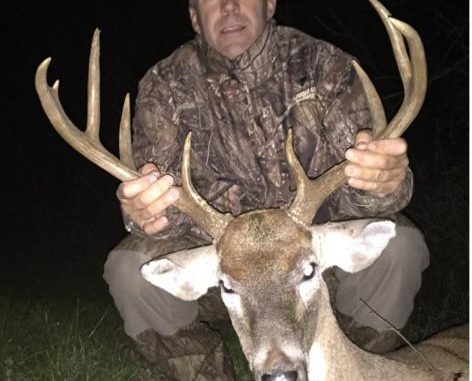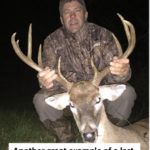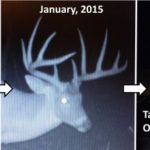
Consistently successful hunters take time to prepare
As I write this month’s “Happy Trails” column, the 2014-2015 Mississippi deer season here in Central Mississippi has just ended.
Regarding trophy buck success, from what I am hearing and from what I experienced personally, it all depends on just who you talk to. Statewide results seem to have been mixed for a variety of possible reasons.
I recently read where one prominent Mississippi deer specialist noticed that in many areas this year, deer seem to have become more nocturnal, plus a bumper acorn crop and spells of mild weather kept overall deer movement suppressed.
This particular deer expert attributed this year’s drop in deer sightings and daytime deer movement to several potential causes. That list includes increasing use of ATVs to get around on hunting properties, hunters becoming way too predictable and using the same stands day after day and the supplemental feeding of deer all through the season.
My own personal observation over the last several years is that, whether the specific timing of such is legal or not, deer corn is being put out profusely by many hunters across the entire deer season. This can drastically affect deer movement patterns.
Now, believe me, I am looking in the mirror when I write this, although my personal use of corn feeders has been strictly limited to the short lawful period of time for supplemental corn feeding that begins each Dec. 1. In my book, there can certainly be places and times where properly administered supplemental feeding is not detrimental.
Regarding hunting pressure and overall disturbance of a hunting property by human actions, less is more, and I mean way more. Whitetail deer, and especially older mature bucks, are extremely sensitive to human disturbance. I think that this is particularly true in locales where human disturbance is more seasonal, coinciding mainly with the deer season. I know several very successful deer hunters that hardly missed a beat success-wise during this just finished season. And their success is in spite of the persistent reports by others of poor results and an overall decrease in deer sightings. A common thread between these perennially successful hunters is their penchant for being stealthy and for taking care of the little details that make so much difference. A lot of people might attribute such success to luck, but consistent, year-to-year success in bagging older mature bucks is rooted solidly in the wise old saying that luck usually occurs when preparation meets opportunity.
A good case in point involves Tad Owens’ two year quest for one particular old buck that he first became acquainted with during the 2013-2014 season. As so often happens, his very first glimpse of the deer came via trail camera. The general area where Tad’s story takes place is in west central Mississippi.
Tad’s first glimpse of the subject buck was by way of trail camera photos back in early January, 2014. The buck’s very symmetrical rack appeared to be in the 150-inch class. It was late in the season as the rut wound down, but he was getting photos of the ole boy on a fairly regular basis, some of which were taken during the daytime. Knowing that he had to act quickly, he quietly eased into the target area and put up a two-person ladder stand. You see, he had been working hard to get his 10-year-old son on a good buck, so the ladder stand was a must.
On a day when the wind was just right, the two of them went to the stand, and like the trail cam photos suggested the deer would, the buck came in to feed on acorns just before dark. At one point the buck was only about 55 or so yards away, but due to a little “buck fever” and rapidly failing light, his son never felt totally comfortable with the shot. After dark, they silently crept out of the stand and headed home.
From the standpoint of adding another year’s growth to the buck’s antlers, it was absolutely the best thing that could have happened. At the deer’s level of maturity and with the quantity of bone that the buck was already carrying, it was well within reason for such a buck to have the potential to add an additional 20-plus inches of antler by the following season.
Now, let’s fast forward 12 months to January of this year. Tad had his cameras on station all through the pre-rut and rut, and the buck was nowhere to be seen. And then like magic, he reappeared early in the month, just like he did a year earlier.
As expected, the buck’s rack had blown up during the intervening months to monstrous proportions. This buck had a relatively small core area that happened to coincide with where Tad was hunting, but the deer was obviously a “range shifter.”
A web of active trail cameras can literally make a deer hunter’s season if used properly. Tad tells me that he often waits and checks his cameras at night to lessen the “spooking factor.” That is not something that I have ever tried, but I see his point and certainly cannot argue with success.
The buck was cataloged by trail camera coming in late at night and also right before dark at times, and occasionally in the early morning. Tad decided that once the wind was right, he would go in alone with a climber.
The buck’s apparent bedding area was very close to where he was being seen on camera, so extreme stealth was going to be necessary.
On Wednesday afternoon, Jan. 28, Tad had the necessary easterly wind that he had been waiting for. He drove to his hunting spot and after parking, he crept in on foot with his climbing stand, having already picked out a particular tree to climb. As he approached his planned destination he suddenly paused with an eerie sense of destiny, but with a negative feeling about his chosen location. Quickly sizing the situation up, he continued about 80 yards further along the edge of the bedding cover that most likely held his quarry. Using his trail camera photos, Tad had established the buck’s daily routine of slipping out of his bedding area to feed on leftover acorns in an adjacent hardwood bottom.
At about 3:30 p.m., Tad quietly strapped his stand onto the selected tree and slowly eased his way upward into position. Nothing much happened over the next two hours, but Tad just had that “feeling” that most of us have felt ourselves at times.
At 5:30, with only about 30 minutes of shooting light left, he heard footsteps approaching through the leaf litter. Looking intently toward the sound, Tad began to see movement in a deep brushy ditch, which quickly morphed into antler tips. The buck moved slowly but deliberately past Tad’s position, with only his antler tips visible as they weaved and bobbed through the heavy cover. The sound stopped after the buck moved just out of sight. The deer had obviously paused to look, listen and test the wind before stepping out of the thick cover.
Suddenly, with no warning, the buck popped into view about 40 yards from Tad’s position. With only one small opening available in the cover, Tad quickly raised his .308 rifle into position and placed the cross hairs on the opening. As the buck slowly moved into view, Owens squeezed the trigger and sent a custom hand-loaded 155-grain bullet downrange. At the bullets impact, the monstrous buck took off like the devil was after him before running out of steam and crashing to the ground.
With a huge sense of euphoria and satisfaction, Tad gave a fist pump while grinning ear to ear. After climbing down he turned on his flashlight and headed toward where he heard the buck crash. When his flashlight beam lit up the buck’s rack he was stunned, as the rack in person was much more impressive than in trail camera photos.
The gross green score on Tad’s end-of-the-season buck was right at 175 inches. The deer has four antler tines that are more 10 inches long. The rack is almost perfectly symmetrical, with G3s that are more than 12 inches in length. The main beams are both over 24 inches, with just above the burr circumferences of 5 ¾ inches.
There are lessons here for all of us. I intend to try checking my trail cameras next season after dark, and will let you know how it works for me. Way to go, Tad!




